Dynamic Random Arching in the Flow Field of Top-Coal Caving Mining
Abstract
:1. Introduction
2. Physical Granular Simulation Experiment
2.1. Engineering Background
2.2. Experiment Design
3. Experiment Result and Analysis
3.1. Types of Arches
- (1)
- Lower arch. The lower arch is located at the bottom of the flow space near the caving-outlet with a small span, big arching probability and high stability. That’s because the flow space decreases along the vertical direction. The smaller the flow space is, the larger arching probability would be. The lower arch can be formed by coal blocks only (as shown in Figure 2a), or coal and gangue blocks (as shown in Figure 2b). The front skewback of the arch is generally located at the tail beam of the support, while the rear skewback of the arch is located on the gangue of gob.
- (2)
- Middle arch. The middle arch is located at the middle of the flow space (behind the shield beam in horizontal). The span of the middle arch is usually longer than that of the lower arch. The middle arch can be formed by coal blocks only (as shown in Figure 3a) or coal and gangue blocks (as shown in Figure 3b). The front skewback of the arch is generally located on the shield beam or tail beam of the support, the rear skewback of the arch is located on the gangue of gob.
- (3)
- Upper arch. The upper arch is located over the support with a large span, small arching probability and low stability. The front skewback of the arch is generally located on the top beam of the support, the rear skewback of the arch is located on the gangue of gob. The upper arch can be formed by coal blocks only (as shown in Figure 4a) or coal and gangue blocks (as shown in Figure 4b), too.
3.2. Arching Probability and Effect on the Top-Coal Recovery of DRA
3.3. Characteristics of Arches
- (1)
- Arching positions. The arch can be formed in any position in the caving flow space. And the shape and position of the arch may change with the flow of coal and gangue in the flow field. In other words, the arching position is dynamic.
- (2)
- Arching probability. The arching probability of arches in different positions is different. With the contraction of the coal flow field, the probability of arching increases. In other words, the arching probability is random.
- (3)
- Arching materials. The arching materials are not only just coal blocks but also coal and gangue blocks.
- (1)
- Uneven or relative displacement needs to occur.
- (2)
- The support points or constraints should exist to act as the skewback.
3.4. Arching Mechanism of DRA and Its Effect on Top-Coal Caving Process
3.4.1. Arching Mechanism
3.4.2. Affecting Factors
- (1)
- Fragment dimension. Mutual contact and extrusion would have had to occur between the top-coal and gangue in the process of top-coal caving mining. The larger the top-coal/gangue is, the easier it is to squeeze to form a more stable hinge structure, thus forming a stable arch structure. So the coal/gangue fragment dimension and distribution have great influence on the formation of arch structure.
- (2)
- Arch span. The span of the arch structure determines the number of coal/gangue blocks in the arch structure. Usually, the arch structure is relatively stable, once one block in the arch structure is unstable, the whole arch structure is damaged and unstable, so the larger the span of arch structure, the lower stability and higher position of the arch would be.
- (3)
- Horizontal binding force. Because the arch structure usually belongs to the parabolic curve. The constraint of the horizontal force is an important factor to stabilize the arch structure. Usually, the horizontal force can provide the constraint for the skewbacks. And the horizontal binding force can also increase the extrusion between blocks in the arch structure, thus increase of the stability of the whole arch structure.
3.5. Removing Strategies of DRA and Technology Path of Intelligent Top-Coal Caving Mining
3.5.1. Removing Strategies of DRA
3.5.2. Technology Path of Intelligent Top-Coal Caving Based on the Removal Strategies of DRA
4. Discussion
5. Conclusions
- (1)
- According to the layer characteristics and medium composition, the arches are divided into lower, middle and upper arch layers in fully mechanized top coal caving mining of ultra-thick coal seam. The coal and gangue are the medium composition of arches. And there are different arching probability and stability in different layers.
- (2)
- The arch has dynamic and random characteristics. The stability of DRA was influenced by the fragment dimension, arch span and the horizon binding force. The arching probability of the lower arch is higher than others. The arches can be damaged by destabilizing the skewback and adopting the composing sequence.
- (3)
- In the process of top coal caving, the arching probability is reduced and the recovery ratio is improved by means of top coal water softening, improving the working resistance of the supports, oscillating the caving beam, and multi-cycles/multi-openings top coal caving.
- (4)
- The intelligent fully mechanized top coal caving should consider the influences of the arch structure during the caving process. To ensure the maximum recovery of top-coal, the caving technology and support action should be combined to realize the intelligent detecting and removing arches.
Author Contributions
Acknowledgments
Conflicts of Interest
References
- Huang, B.X.; Wang, Y.Z.; Cao, S.G. Cavability control by hydraulic fracturing for top coal caving in hard thick coal seams. Int. J. Rock Mech. Min. Sci. 2015, 74, 45–57. [Google Scholar] [CrossRef]
- Li, M.; Zhang, J.X.; Huang, Y.L.; Gao, R. Measurement and numerical analysis of influence of key stratum breakage on mine pressure in top-coal caving face with super great mining height. J. Cent. South Univ. 2017, 24, 1881–1888. [Google Scholar] [CrossRef]
- Li, S.; Fan, C.J.; Luo, M.K.; Yang, Z.H.; Lan, T.W.; Zhang, H.F. Structure and deformation measurements of shallow overburden during top coal caving longwall mining. Int. J. Min. Sci. Technol. 2017, 27, 1081–1085. [Google Scholar] [CrossRef]
- Wang, X.F.; Wang, Y.; Zhang, D.S.; Wang, H.Z.; Zhang, Y.; Qin, D.D.; Zhang, C.G. Characteristics of strata behavior during thick seam mining by fully-mechanized top coal caving in a loess-covered gullied region. Minerals 2017, 7, 63. [Google Scholar] [CrossRef]
- Chi, M.B.; Zhang, D.S.; Fan, G.W.; Zhang, W.; Liu, H.L. Prediction of top-coal caving and drawing characteristics by the analytic hierarchy process-fuzzy discrimination method in extra-thick coal seams. J. Intell. Fuzzy Syst. 2017, 33, 2533–2545. [Google Scholar] [CrossRef]
- Kong, D.Z.; Wang, Z.H.; Li, X.M.; Wang, Y.L.; Wang, C. Study of reasonable width of full-mechanized top-coal caving with large mining height. Rock Soil Mech. 2014, 35, 460–466. [Google Scholar]
- Liu, Y.J.; Wang, X.M. Technology Research on the Fourth Panel Mining Large Height Fully-Mechanized Caving Mining in Shangwan Coal Mine. In Proceedings of the International Conference on Engineering Technology and Application, Xiamen, China, 29–30 May 2015; Li, J.Y., Liu, T.Y., Deng, T., Tian, M., Eds.; EDP Sciences: Les Ulis, France, 2015; Volume 22. [Google Scholar]
- Li, H.M.; Peng, S.; Li, H.G.; Xu, Y.X.; Yuan, R.F.; Yue, S.S.; Li, K. Trial of small gateroad pillar in top coal caving longwall mining of large mining height. Int. J. Min. Sci. Technol. 2016, 26, 139–147. [Google Scholar] [CrossRef]
- Wang, J.H. Demonstration project of safe and efficient mining operations in extra-thick coal seam. Front. Eng. Manag. 2016, 3, 264–274. [Google Scholar] [CrossRef]
- Guo, J.S.; Ma, L.Q.; Wang, Y.; Wang, F.T. Hanging wall pressure relief mechanism of horizontal section top-coal caving face and its application—A case study of the Urumqi coalfield, China. Energies 2017, 10, 1371. [Google Scholar] [CrossRef]
- Li, Z.; Xu, J.L.; Yu, S.C.; Ju, J.F.; Xu, J.M. Mechanism and prevention of a chock support failure in the longwall top-coal caving faces: A case study in Datong coalfield, China. Energies 2018, 11, 288. [Google Scholar] [CrossRef]
- Ren, P.; Qian, J.S. A power-efficient clustering protocol for coal mine face monitoring with wireless sensor networks under channel fading conditions. Sensors 2016, 16, 835. [Google Scholar] [CrossRef] [PubMed]
- Xie, J.C.; Yang, Z.J.; Wang, X.W.; Wang, S.P.; Zhang, Q. A joint positioning and attitude solving method for shearer and scraper conveyor under complex conditions. Math. Probl. Eng. 2017, 2017, 3793412. [Google Scholar] [CrossRef]
- Wang, J.H.; Huang, Z.H. The recent technological development of intelligent mining in China. Engineering 2017, 3, 439–444. [Google Scholar] [CrossRef]
- Yang, Y.S.; Li, X.W.; Zhang, L.Z. Research on Hydraulic Support Selection of Unmanned Fully-Mechanized Coal Mining Face. In Proceedings of the 2016 7th International Conference on Mechatronics, Control and Materials (ICMCM 2016), Changsha, China, 29–30 October 2016; Volume 104, pp. 295–301. [Google Scholar]
- Li, X.S.; Lu, J. Design and Application of Interface Circuit of Coal Mine Equipment Intelligent Management System TCP/IP Module. In Proceedings of the 2016 6th International Conference on Machinery, Materials, Environment, Biotechnology and Computer (MMEBC), Tianjin, China, 11–12 June 2016; Volume 88, pp. 1869–1874. [Google Scholar]
- Yu, G.H.; Wang, S.Y. The Design of Gas Monitoring System Based on the Prediction Model. In Proceedings of the 2016 6th International Conference on Machinery, Materials, Environment, Biotechnology and Computer, Tianjin, China, 11–12 June 2016; Zhang, L., Xu, D., Eds.; Atlantis Press: Paris, France, 2016; Volume 88, pp. 1910–1915. [Google Scholar]
- Song, Q.J.; Jiang, H.Y.; Zhao, X.G.; Li, D.M. An automatic decision approach to coal-rock recognition in top coal caving based on MF-score. Pattern Anal. Appl. 2017, 20, 1307–1315. [Google Scholar] [CrossRef]
- Zhang, G.X.; Wang, Z.C.; Zhao, L.; Qi, Y.Z.; Wang, J.S. Coal-rock recognition in top coal caving using bimodal deep learning and hilbert-huang transform. Shock Vib. 2017, 2017, 3809525. [Google Scholar] [CrossRef]
- Zhang, G.X.; Wang, Z.C.; Zhao, L. Recognition of rock-coal interface in top coal caving through tail beam vibrations by using stacked sparse autoencoders. J. Vibroeng. 2016, 18, 4261–4275. [Google Scholar]
- Zhang, N.B.; Liu, C.Y.; Yang, P.J. Flow of top coal and roof rock and loss of top coal in fully mechanized top coal caving mining of extra thick coal seams. Arab. J. Geosci. 2016, 9, 465. [Google Scholar] [CrossRef]
- Guo, W.B.; Tan, Y.; Bai, E.H. Top coal caving mining technique in thick coal seam beneath the earth dam. Int. J. Min. Sci. Technol. 2017, 27, 165–170. [Google Scholar] [CrossRef]
- Zhang, N.B.; Liu, C.Y.; Pei, M.S. Effects of caving-mining ratio on the coal and waste rocks gangue flows and the amount of cyclically caved coal in fully mechanized mining of super-thick coal seams. Int. J. Min. Sci. Technol. 2015, 25, 145–150. [Google Scholar] [CrossRef]
- Bai, Q.; Tu, S.; Wang, C. Numerical simulation on top-coal arching mechanisms. J. Min. Saf. Eng. 2014, 31, 208–213. [Google Scholar]
- Yu, B.; Xia, H.C.; Meng, X.B. Top coal arching mechanism and arch removal strategies in fully mechanized top coal caving mining of ultra-thick coal seam. J. China Coal Soc. 2016, 41, 1617–1623. [Google Scholar]
- Bychkov, I.V.; Vladimirov, D.Y.; Oparin, V.N.; Potapov, V.P.; Shokin, Y.I. Mining information science and big data concept for integrated safety monitoring in subsoil management. J. Min. Sci. 2016, 52, 1195–1209. [Google Scholar] [CrossRef]
- Guo, P.J.; Zhou, S.H. Arch in granular materials as a free surface problem. Int. J. Numer. Anal. Methods Geomech. 2013, 37, 1048–1065. [Google Scholar] [CrossRef]
- Vivanco, F.; Rica, S.; Melo, F. Dynamical arching in a two dimensional granular flow. Granul. Matter 2012, 14, 563–576. [Google Scholar] [CrossRef]
- Perry, M.G.; Handley, M.F. Dynamic arch in free flowing granular materialdischarging from a model hopper. Trans. Inst. Chem. Eng. 1967, 45, T367. [Google Scholar]
- Duran, J.; Kolb, E.; Vanel, L. Static friction and arch formation in granular materials. Phys. Rev. E 1998, 58, 805–812. [Google Scholar] [CrossRef]
- Peralta-Fabi, R.; Malaga, C.; Rechtman, R. Arching in confined dry granular materials. Europhys. Lett. 1999, 45, 76–82. [Google Scholar] [CrossRef]
- Liu, C.Y.; Huang, B.X.; Wu, F.F. Fragment dimension theory and its application in fully mechanized top coal caving. J. Min. Saf. Eng. 2006, 23, 56–61. [Google Scholar]
- Lu, Z.H. The mechanism analysis of flowing agricultural particle material arching in hole. Trans. Chin. Soc. Agruc. Eng. 1991, 7, 78–85. [Google Scholar]
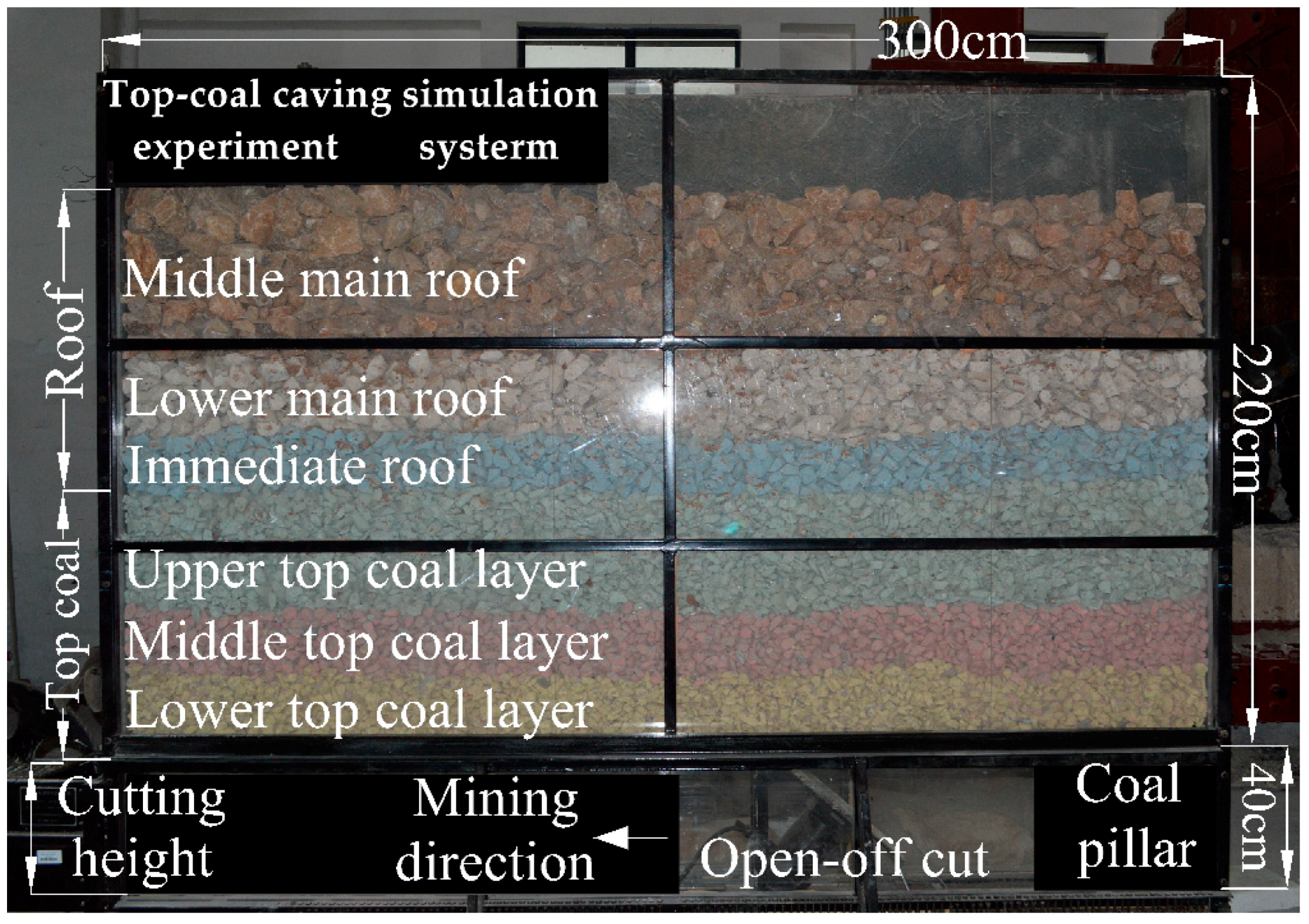
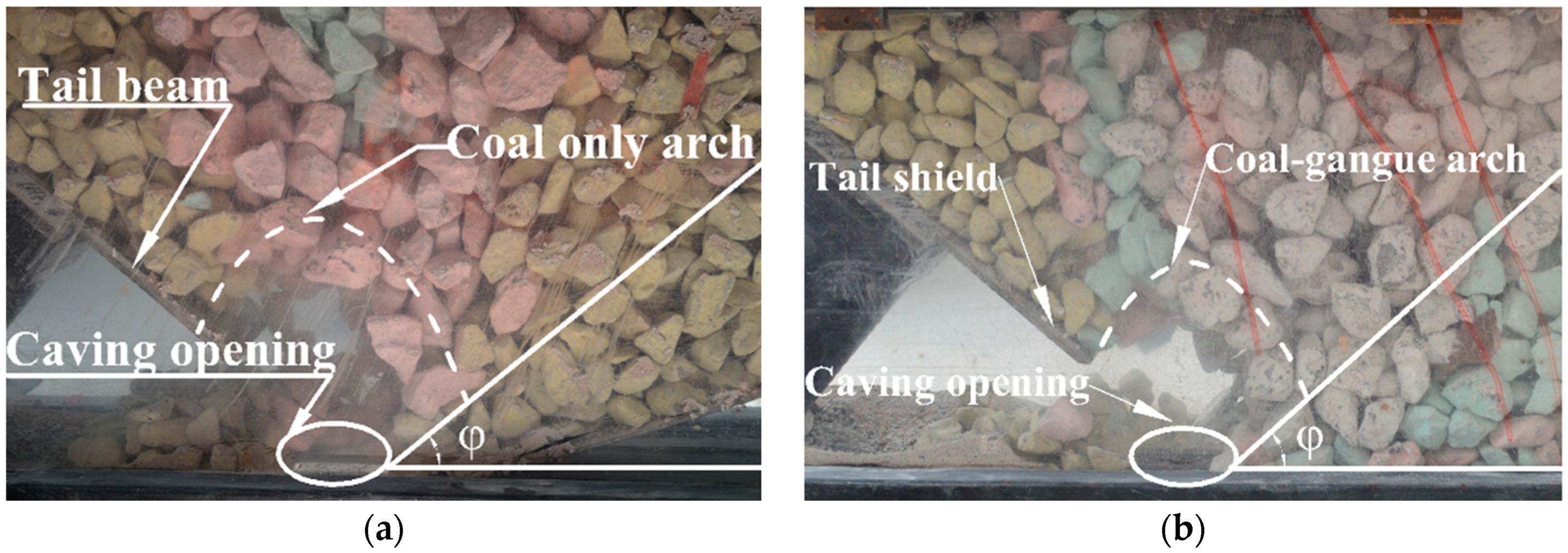
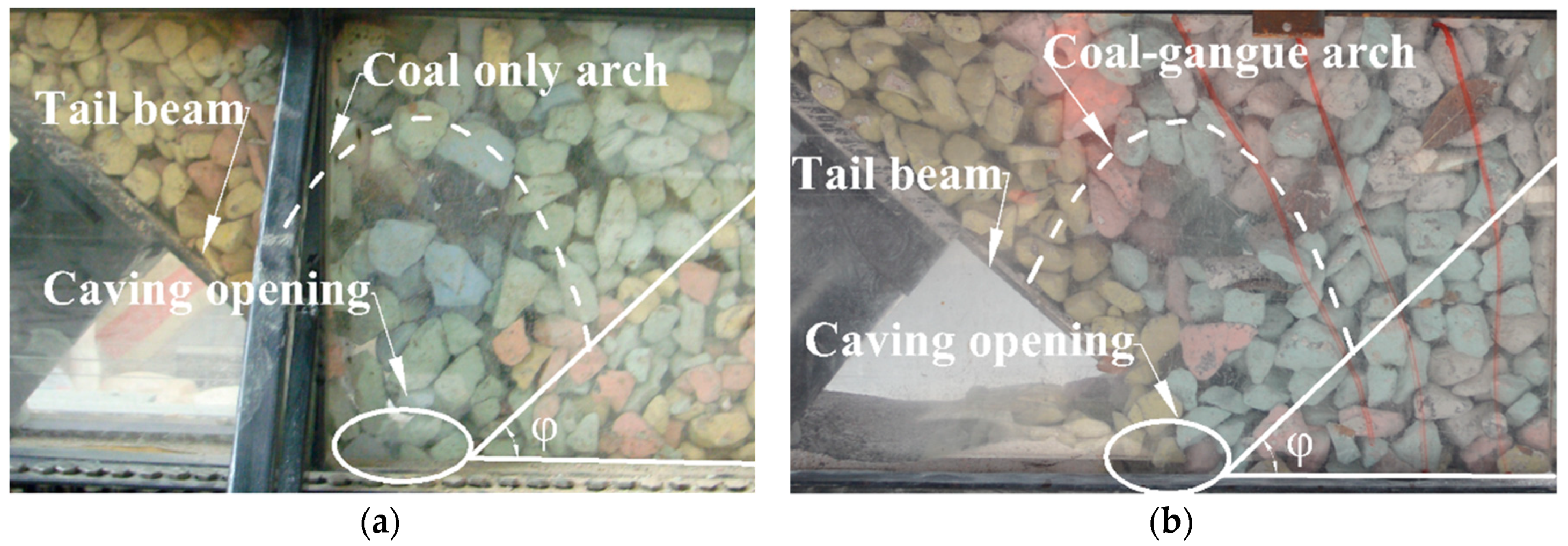
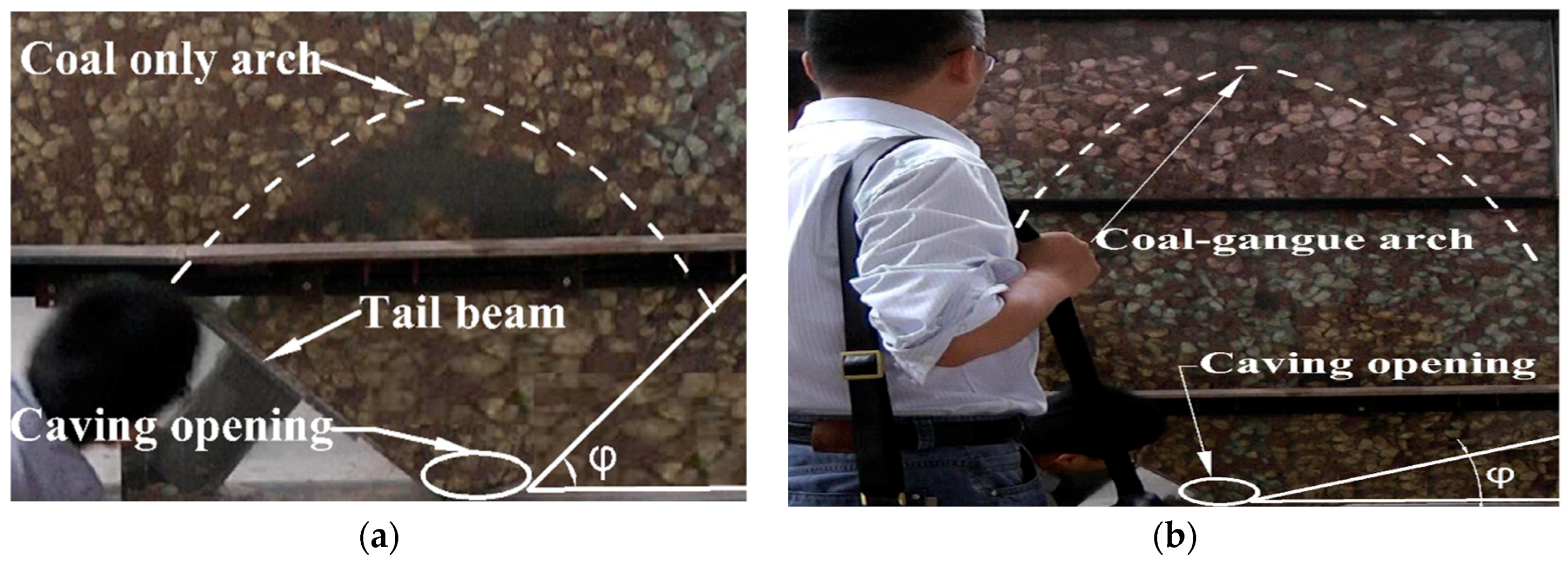





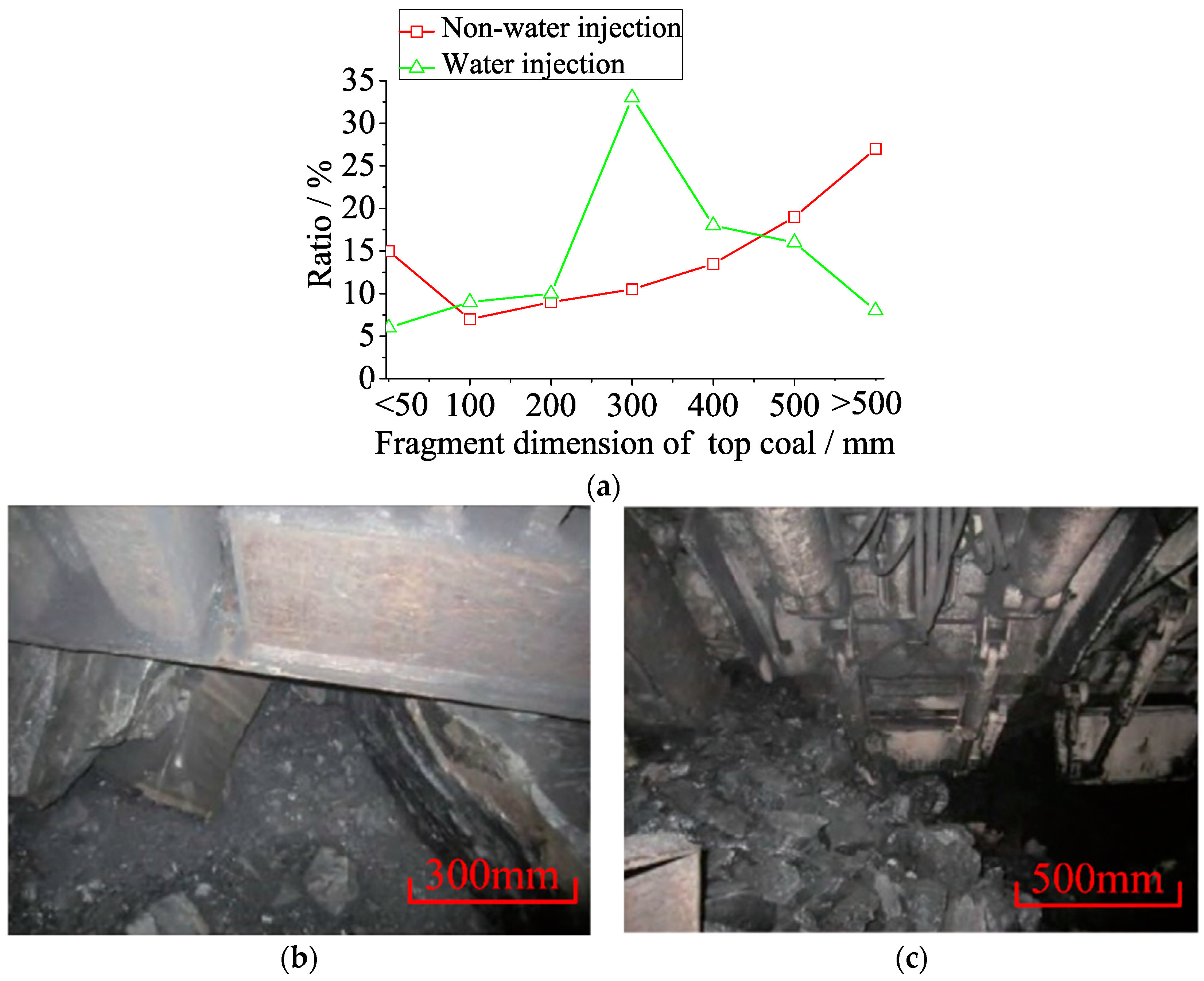
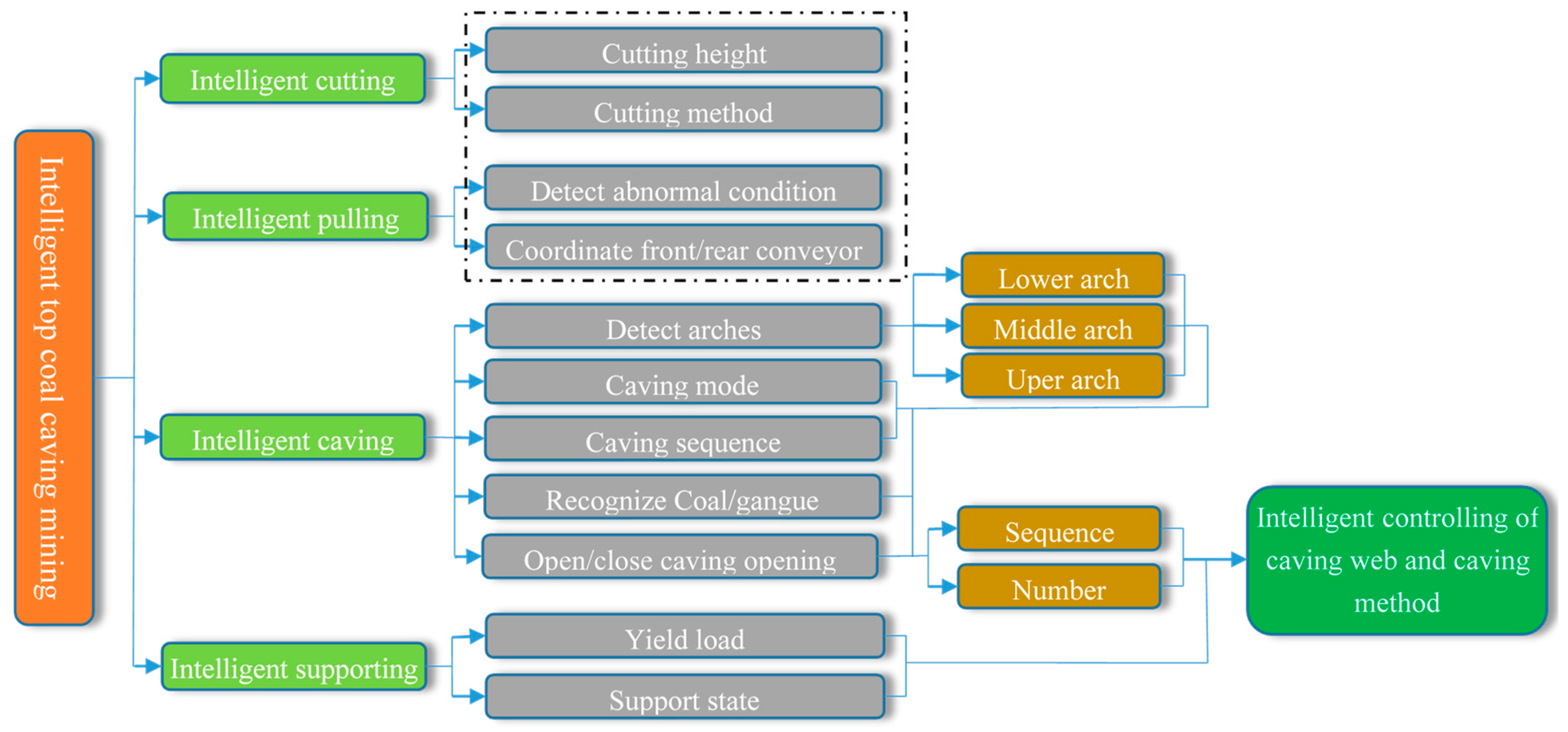
| Layer | Parameters | |
|---|---|---|
| Thickness (mm) | Dimension (mm) | |
| Middle main roof | 600 | 90 |
| Lower main roof | 400 | 75 |
| Immediate roof | 332 | 70 |
| Upper top-coal layer | 378 | 55 |
| Middle top-coal layer | 300 | 45 |
| Lower top-coal layer | 300 | 27 |
| Type of Arches | Times | Arching Probability (%) | Arch Ratio (%) | Recovery Ratio (%) | |
|---|---|---|---|---|---|
| Upper arch | Coal only arch | 1 | 5 | 1.04 | 60.30 |
| Coal-gangue arch | 2 | 10 | 2.08 | 78.80 | |
| Middle arch | Coal only arch | 9 | 45 | 9.38 | 51.34 |
| Coal-gangue arch | 7 | 35 | 7.29 | 63.23 | |
| Lower arch | Coal only arch | 56 | 280 | 58.33 | 24.14 |
| Coal-gangue arch | 21 | 105 | 21.88 | 82.23 | |
© 2018 by the authors. Licensee MDPI, Basel, Switzerland. This article is an open access article distributed under the terms and conditions of the Creative Commons Attribution (CC BY) license (http://creativecommons.org/licenses/by/4.0/).
Share and Cite
Zhang, N.; Liu, C.; Wu, X.; Ren, T. Dynamic Random Arching in the Flow Field of Top-Coal Caving Mining. Energies 2018, 11, 1106. https://doi.org/10.3390/en11051106
Zhang N, Liu C, Wu X, Ren T. Dynamic Random Arching in the Flow Field of Top-Coal Caving Mining. Energies. 2018; 11(5):1106. https://doi.org/10.3390/en11051106
Chicago/Turabian StyleZhang, Ningbo, Changyou Liu, Xiaojie Wu, and Tingxiang Ren. 2018. "Dynamic Random Arching in the Flow Field of Top-Coal Caving Mining" Energies 11, no. 5: 1106. https://doi.org/10.3390/en11051106
APA StyleZhang, N., Liu, C., Wu, X., & Ren, T. (2018). Dynamic Random Arching in the Flow Field of Top-Coal Caving Mining. Energies, 11(5), 1106. https://doi.org/10.3390/en11051106




